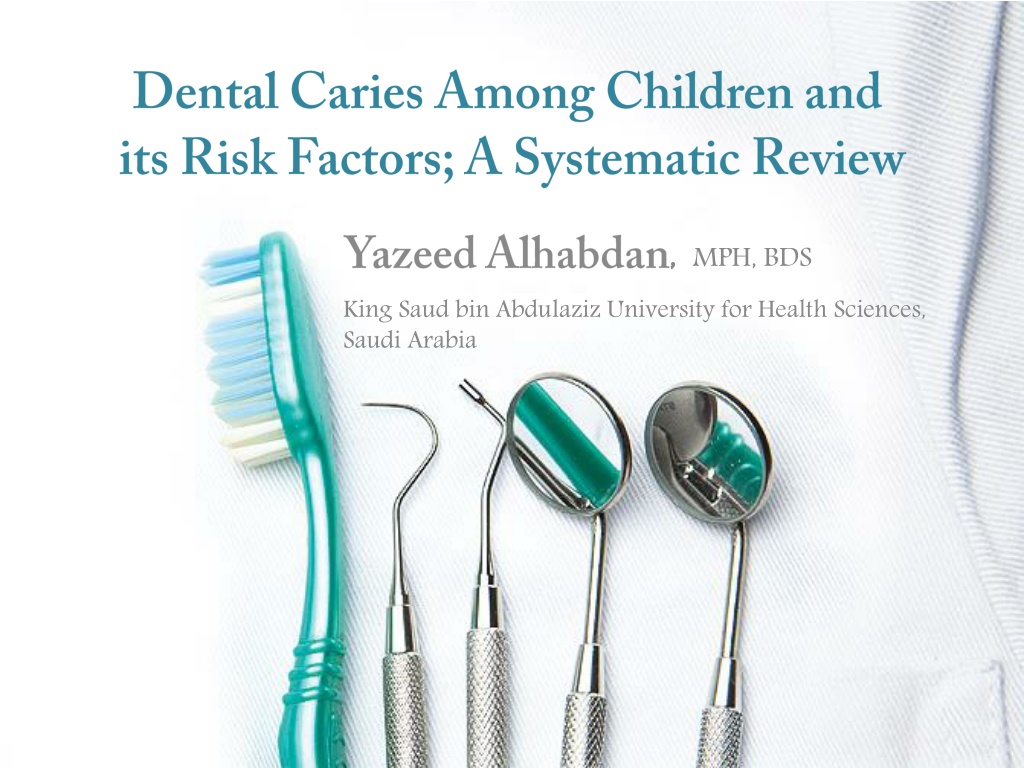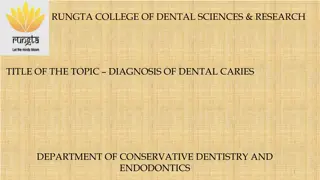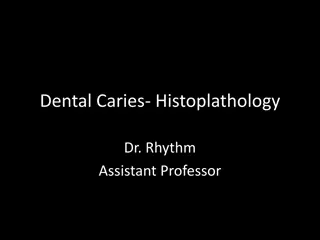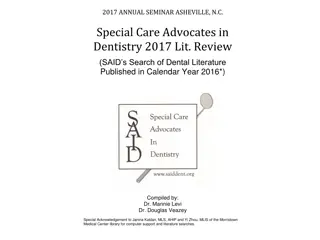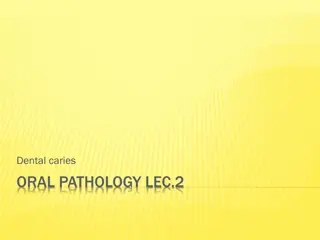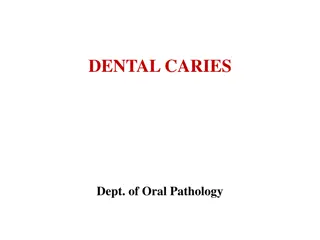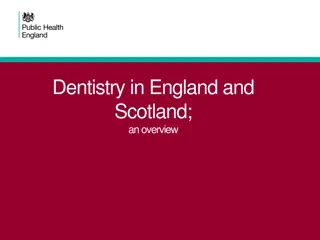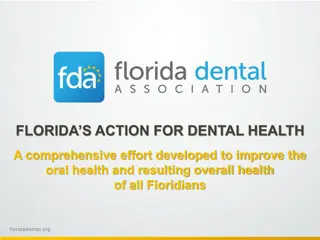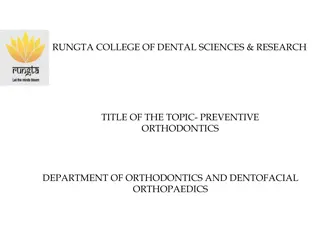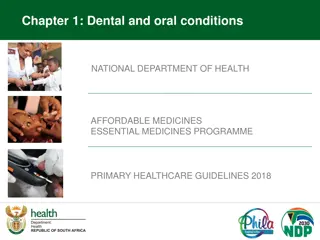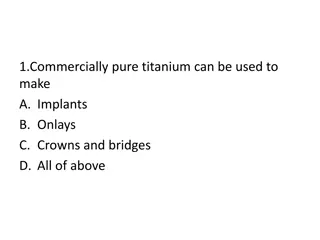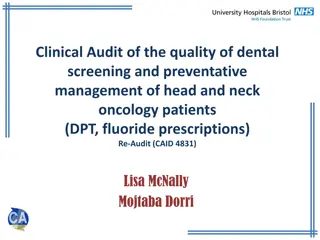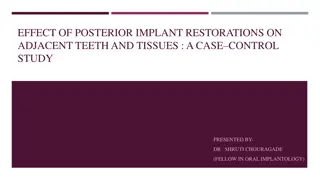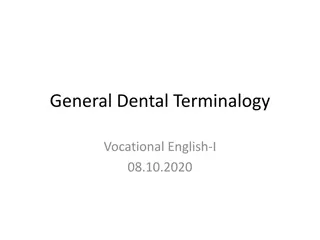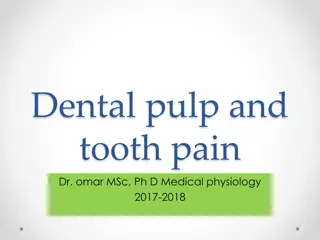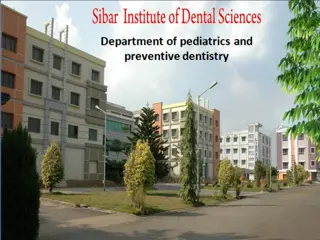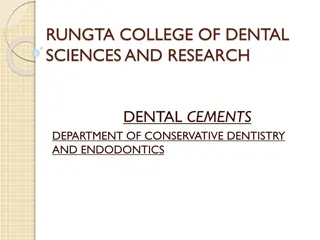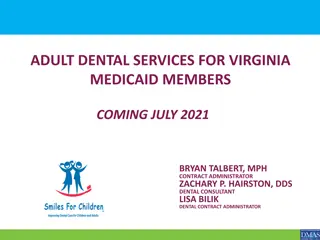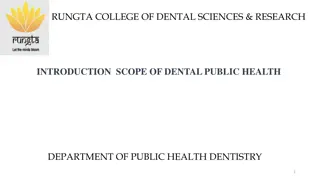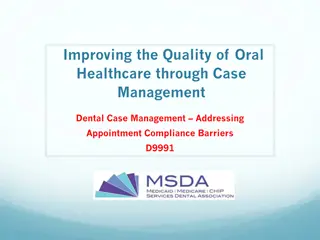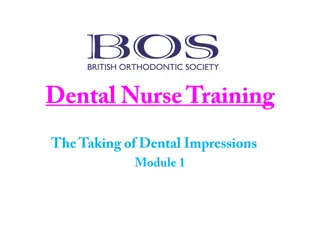Understanding Dental Caries: Impact, Prevalence, and Prevention
Dental caries, an infection causing demineralization of teeth, is a common and significant issue, especially among children. The presentation discusses the risks, etiology, and impact of dental caries, emphasizing its effects on children's growth, nutrition, social interactions, and overall well-being. Despite global efforts, WHO's goals for reducing dental caries prevalence remain unmet for a substantial population. Awareness and preventive measures are crucial in combating this widespread issue.
Download Presentation

Please find below an Image/Link to download the presentation.
The content on the website is provided AS IS for your information and personal use only. It may not be sold, licensed, or shared on other websites without obtaining consent from the author. Download presentation by click this link. If you encounter any issues during the download, it is possible that the publisher has removed the file from their server.
E N D
Presentation Transcript
, , MPH, BDS King Saud bin Abdulaziz University for Health Sciences, Saudi Arabia
The audience by the end of this presentation will be able to: Determine the risk of the dental caries among children. Identify the etiology and epidemiology of dental caries among children. Explain WHO goals. Discuss our systematic review results and recommendations.
Dental caries is an infection, bacterial in origin, that causes demineralization and destruction of the hard tissues of the teeth. It is one of the most common diseases and most cause of tooth loss in young people. It is painful and can harm nutrition and overall health.
Growth and nutrition of Children could be affected by painful chewing due to dental caries. Dental pain in older children may cause miss of school days. Appearance of the teeth may affect the interact of young people with their society.
Dental caries has physical, social and emotional effect which affect the success and productivity throughout life.
Worldwide, between 60 and 90% of schoolchildren have dental caries. In the United States, dental caries is one of the most common chronic childhood disease, being at least five times more common than asthma. Dental caries is most prevalent in Latin American countries, countries in the Middle East, and South Asia.
Report from developed country indicate a low prevalence and severity of dental caries. In England, the prevalence of dental caries is 17%. Most of the developing countries had a prevalence of dental caries higher than 50%.
In1981, WHO and work dental federation setting some goals to be achieved by the year 2000. Some of these goals were the following: - 50% of 5-6 years old should be caries free - The global average of decayed, missing or filled permanent teeth (DMFT) in 12 years old should be less than 3. - 85% of 18 years old should not have missing teeth. These goals are still not reached for significant proportion of the world 's population.
In 2003, WHO and FDI set a global goals for oral health in 2020. These goals set as a guidance for the planners and policy makers to improve the status of oral health for their populations and according to the prevalence and severity of disease each country specify their target. Baseline information about oral health status and risk factors are important for planning and evaluation of the improvement in oral health.
To determine caries prevalence in primary and permanent teeth of children living in Saudi Arabia and determine the risk factor associated with dental caries.
A systematic review of literature identified via an electronic search through PubMed and review of IHME data with the following criteria: Targeted children and done in Saudi Arabia. Published between 1987-2015
The prevalence of dental caries in primary dentition of children under 6 years old ranged from 63 - 99 % and the mean dmft score ranged from 2.92 6.53. In the permanent dentition, the prevalence ranged from 56.7 - 99 % and the mean DMFT scores ranged from 0.78 to 5.94. However, this finding indicate that the WHO goals for 2000 are still unmet in Saudi Arabia.
In 2010 Dental caries cause 0.20% of total DALYs worldwide and middle east countries are the highest countries affected by dental caries. The highest percentage of total DALYs is found in Qatar which is 0.46% followed by United Arab emerita 0.44%.
The higher percentage of dally found in age between 5-9 years old which is 0.94%
0.37% 0.27%
Dental caries is a serious public health problem in Saudi Arabia.
Poor oral hygiene practices. 57.8% of those affected by caries had significantly lower oral hygiene practice compared with caries free children (OR=2.8) . (Amin and Al Abad, 2008). Poor diet and Excessive consumption of sugary or acidic foods and drinks. 85% of the children with caries had higher exposure to cariogenic food including sugar than caries free children. (Amin and Al Abad, 2008).
Poorly formed enamel such as deep developmental grooves. The prevalence of enamel defect observed was 45.4% in children 4-5 years old 75.4% of children with caries had DED (Farsi N, 2010). Reduced salivary flow rate ( dry mouth) Buffering capability of saliva is important to counterbalance the acidic environment created by some foods. Salivary glands could be affect by some of medical condition causing dry mouth such as Sj gren's syndrome and diabetes mellitus. Moreover, 63% of the most commonly prescribed medications list dry mouth as a side-effect.
Inadequate exposure to fluoride Caries reduction could drop from 30% to 50% by adjusting water fluoridation to the optimum level . Low socioeconomic status Dental caries significantly higher among children with low parental educational status (OR=1.7). Amin and Al-Abad (2008) Improper feeding habits in children
Ensuring proper oral hygiene practices. Encouraging less consumption of sugars and maintaining a well-balanced nutritional intake Increase awareness about important of use fluoridated toothpaste. Educate mothers about not putting child to sleep in the bed with a bottle of milk, juice or other product that contain sugar.
Apply pit and fissure sealant A reduction in dental caries range from 60% to 87% post-application. Regular dental check up
More oral health education programs must be deployed in attempt to control oral disease, and school based approaches should be combined with family and community preventive programs. High number of untreated caries in these children require immediate attention. However, dental caries is both curable and preventable and therefore should be given the top priority and the full resources.
1. Roberson T, Heymann HO, Swift Jr EJ. Sturdevant's art and science of operative dentistry: Elsevier Health Sciences; 2006. 2. Johnson C, Heiss M, Kolar L, Luksha L. Biology of the Human Dentition. Illinois University, Chicago College of Dentistry. 1998. 3. Hartmann, Richard W. Ludwig's Angina in Children. American Academy of Family Physicians website. 2008. 4. Soames JV, Southam JC. Oral pathology: Oxford University Press; 1993. 5. Kidd E, Smith B. pickard HM. pickardss manual of operative dentistry. Oxford University press; 1990. 6. Gautam D, Vikas J, Amrinder T, Rambhika T, Bhanu K. Evaluating dental awareness and periodontal health status in different socioeconomic groups in the population of Sundernagar, Himachal Pradesh, India. Journal of International Society of Preventive & Community Dentistry. 2012; 2(2): 53. 7. Neville BW, Douglas Damm, Carl Allen, Jerry Bouquot. Oral & Maxillofacial Pathology; 2002. 8. Edelstein B. The dental caries pandemic and disparities problem. BMC Oral Health. 2006; 6(Suppl 1): S2. 9. Petersen P, Razanamihaja N, Poulsen V. Surveillance of oral health among children and adults in Madagascar. Geneva, Switzerland: WHO. 2004. 10. Vos T, Flaxman AD, Naghavi M, Lozano R, Michaud C, Ezzati M, et al. Years lived with disability (YLDs) for 1160 sequelae of 289 diseases and injuries 1990 2010: a systematic analysis for the Global Burden of Disease Study 2010. The Lancet. 2013; 380(9859): 2163-96. 11. Organization WH. Oral health. [cited; Available from: http://www.who.int/mediacentre/factsheets/fs318/en/ 12. Petersen PE. The World Oral Health Report 2003: continuous improvement of oral health in the 21st century the approach of the WHO Global Oral Health Programme. Community dentistry and oral epidemiology. 2003; 31(s1): 3-24. 13. People H. Html version hosted on Healthy People. gov website. Page accessed August. 2010; 13: 2006. 14. Gregory J, Collins P, Davies P, Hughes J, Clarke P. National Dietary and Nutritional Survey: children aged 11 2 to 41 2 years. Volume; 1995. 15. Stephen K. Caries in young populations-worldwide. Cariology for the Nineties. 1993: 37-50.
16. Organization WH. Oral health surveys: basic methods World Health Organization. Geneva, Switzerland. 1997. 17. Li Y, Wang W. Predicting caries in permanent teeth from caries in primary teeth: an eight-year cohort study. Journal of dental research. 2002; 81(8): 561-6. 18. Organization WH. Oral Health Information Systems. Geneva, Switzerland. 1981. 19. Petersen PE, Bourgeois D, Ogawa H, Estupinan-Day S, Ndiaye C. The global burden of oral diseases and risks to oral health. Bulletin of the World Health Organization. 2005; 83(9): 661-9. 20. Hobdell M, Petersen PE, Clarkson J, Johnson N. Global goals for oral health 2020. International dental journal. 2003; 53(5): 285-8. 21. Al Shammery AR, Guile EE, EI Backly M. Prevalence of caries in primary school children in Saudi Arabia. Community dentistry and oral epidemiology. 1990; 18(6): 320-1. 22. Al Banyan R, Echeverri E, Narendran S, Keene H. Oral health survey of 5 12 year old children of National Guard employees in Riyadh, Saudi Arabia. International Journal of Paediatric Dentistry. 2000; 10(1): 39-45. 23. Wyne AH, Al-Ghannam NA, Al-Shammery AR, Khan NB. Caries prevalence, severity and pattern in pre- school children. Saudi medical journal. 2002; 23(5): 580-4. 24. Al Malik MI, Holt RD, Bedi R. Erosion, caries and rampant caries in preschool children in Jeddah, Saudi Arabia. Community dentistry and oral epidemiology. 2002; 30(1): 16-23. 25. Aldosari A, Wyne A, Akpata E, Khan N. Caries prevalence and its relation to water fluoride levels among schoolchildren in Central Province of Saudi Arabia. International dental journal. 2004; 54(6): 424-8. 26. Al-Sadhan S. Dental caries prevalence among 12-14 year-old schoolchildren in Riyadh: A 14 year follow-up study of the Oral Health Survey of Saudi Arabia Phase I. Saudi Dental Journal. 2006; 18(1): 2-7. 27. Farsi N. Developmental enamel defects and their association with dental caries in preschoolers in Jeddah, Saudi Arabia. Oral health & preventive dentistry. 2010; 8(1): 85. 28. Al Agili D, Niazy H, Pass M. Prevalence and socioeconomic determinants of dental sealant use among schoolchildren in Saudi Arabia. EMHJ. 2012; 18(12). 29. Amin T, Al Abad B. Oral hygiene practices, dental knowledge, dietary habits and their relation to caries among male primary school children in Al Hassa, Saudi Arabia. International journal of dental hygiene. 2008; 6(4): 361-70. 30. Alaki SM, Ashiry E, Bakry NS, Baghlaf KK, Bagher SM. The effects of asthma and asthma medication on dental caries and salivary characteristics in children. Oral Health Prev Dent. 2013; 11(2): 113-20.
